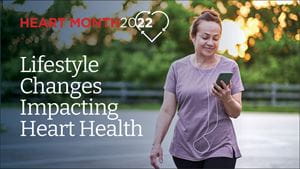
Living a healthy lifestyle is a series of small choices that, when added up, help the body function at its best.
Two of the most powerful choices that can influence our overall wellness are what we eat and how often we are physically active.
Gaurav Sharma, MD, is a cardiologist with Rochester Regional Health. He describes what a healthy life looks like and different changes people can make to keep their heart in good health.
A Gallup survey found 45 percent of full-time employees in the U.S. worked from home full-time or part-time during fall 2021 due to the COVID-19 pandemic. For some of those workers, this means increased time sitting at a desk and being more sedentary than before the pandemic.
One of the most direct health impacts of a sedentary lifestyle is weight gain. Weight gain can lead to other risk factors that put a person at an elevated risk for heart problems, specifically cardiovascular disease.
These include:
“The trouble with these issues is that they can have a snowball effect with the heart,” Dr. Sharma said. “Small things add up over time and create more potential for the heart to experience a problem.”
Other risk factors that can affect an individual’s heart health are family history and smoking. With genetic history, ensuring you are established with your doctor so they know all of your history helps them have a better sense of how they can help you.
Eating whole and minimally-processed foods is a good way to give your body the nutrients it needs to keep functioning at a high level. Do your best to choose plant-based foods over meats whenever given the choice.
Fewer than 1 in 4 Americans know that plant-based diets are heart healthy, according to a Cleveland Clinic Heart Month survey published in February.
Avoid a diet that is composed mainly of refined foods, including those heavy in refined carbohydrates. Some of these foods are:
Choosing plenty of fruits and vegetables as part of your daily eating is a good way to go. Dr. Sharma suggests making fruits and vegetables about half of your daily food intake; the other half can be split between whole grains and lean proteins. Picking lean proteins that are more plant-based than animal-based – such as beans, nuts, or lentils – is better for your heart because of lower saturated fat content.
“Saturated fats contribute to issues such as high cholesterol and insulin resistance – which can lead to type 2 diabetes,” Dr. Sharma said. “This can lead to complications such as heart attacks and strokes, as well as death from heart issues.”
A national Cleveland Clinic Heart Month survey revealed 77% of Americans say that they often or sometimes sit throughout the day.
There are a number of active ways to move toward a heart-healthy lifestyle and lessen your risk of heart troubles. Choosing one at a time is a good way to start.
A few ideas:
“Any level of activity is better than nothing,” Dr. Sharma said. “You don’t need to wake up tomorrow and sign up to run a marathon. Taking small steps, sometimes literally, goes a long way. The simple things matter.”
Increased levels of stress can put more strain on the body, potentially leading to higher blood pressure – a risk factor for cardiovascular problems.
Thankfully there are numerous stress reduction practices and techniques. A few suggestions:
Physical activity (such as the methods mentioned above) can release endorphins – chemicals produced by the body’s nervous system that act as a natural pain and stress reliever.
If you are working from home and work is stressful, do your best to create a structured separation between work and home to reduce that stress.
Getting a full 8 hours of sleep each night allows your body to heal itself and rest. You can help your body get into a more sleep-friendly state by limiting your caffeine intake, avoiding alcohol consumption within 3 hours of bedtime, and reducing the amount of screen time before bed.
There are resources available online that are helpful for lifestyle changes. Guides for daily healthy eating and other recommendations for proper nutrition, such as Forks Over Knives, are a good place to start.
Learning how to read a nutrition label is also an important skill to have. This will help you make healthier choices when eating, especially since a food labeled as ‘low fat’, ‘organic’, or ‘natural’ may not be the most nutritious option.
“Some people may not be aware of the marketing behind food products,” Dr. Sharma said. “Always scrutinize the kind of foods you are being sold – healthy or unhealthy.”
Our Preventative Cardiology specialists with the Sands-Constellation Heart Institute Cardiology team are here to help you understand any potential risks and can work with high-risk individuals to develop a personalized treatment plan to reduce the likelihood of developing cardiovascular disease.